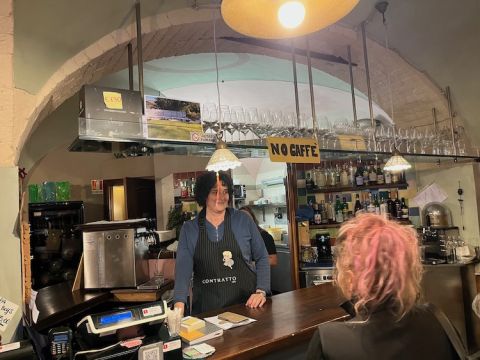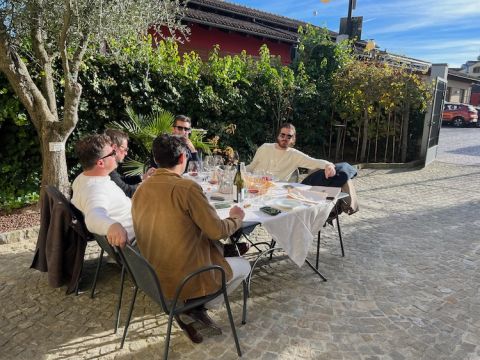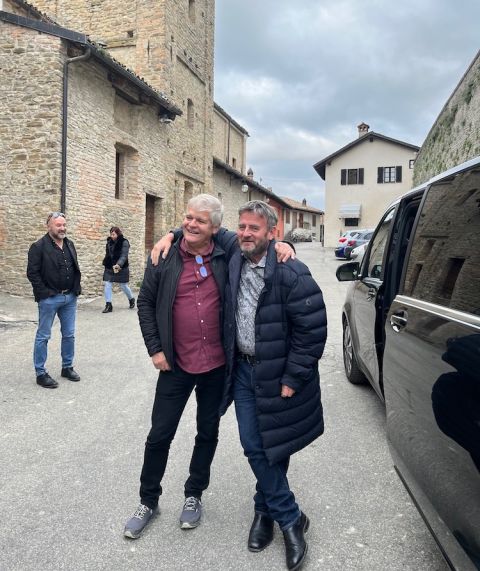Stephen Browett is one of the most interesting and successful characters in the British wine trade. He started out as a van driver, by chance for a wine company. One of the wine merchants he delivered to, Barry Phillips of Four Walls Wine in Sussex, recognised Browett’s curiosity about what he was paid to deliver and started to teach him how to taste.
He turned out to be a skilled taster and, with time, proved himself an even better businessman. Farr Vintners, of which he is now owner, operated out of a bedsit in the early days. Today it is one of the most important and respected fine-wine traders in the world. It branched out to Hong Kong even before the territory became an important wine hub, and now has snazzy headquarters beside the river Thames in Wandsworth. Farr sold so much bordeaux to the Chinese when the market peaked with the 2009 and 2010 vintages that Browett was able to buy a quarter-share in the Premier League football team, Crystal Palace, that had dominated his south London childhood.
Bordeaux is his thing, supplemented by other French wines. Italian wine is not. When I asked him, for an article back in 2014, about Farr’s response to increasing British interest in Barolo, his defiant answer was, 'What is Barolo?' More recently I heard of a young wine professional’s dismay at seeing Browett pour away, without even tasting it, his share of the £300 bottle of Italian wine the young man had brought to a lunch.
A fellow Palace supporter, David Gleave, who has also built up a very successful wine company, Liberty Wines, this time on the back of his expertise in Italian wine, decided last year to educate Browett’s mind and palate. He realised that he needed more bait than just the promise of some of Italy’s finest wines, so he proposed to organise for Browett and his wife Sophie and me and my husband Nick Lander, a tour of Piemonte’s superlative restaurants, subtly interspersed with visits to some of the region’s top wine producers, timed to coincide with the famous white-truffle season last November.
Our trip was to be Friday to Tuesday but Browett took a look at the itinerary and sent Gleave an email: ‘For Sophie and for me it’s more the region, the restaurants and the truffles rather than the visits and tastings ... Perhaps we could come on the trip part-time and duck out early?’ He went ahead and booked their return flights on the Sunday, two days before us, limiting his exposure to the wines of Piemonte to four meals and visits to just three wineries: Gaja, Aldo Conterno and Massolino.
We flew out together on the Friday and, seeing the Browetts had checked-in luggage, I seriously wondered whether he had packed a few bottles of bordeaux just in case, so to speak. I have seen him produce a mature classed growth or two on many occasions but this was not to be one of them.
That afternoon we checked in to our lodgings in Monforte d’Alba, and enjoyed the view shown at the top of this article. We were blessed by weather that even the locals said was exceptional: crisp sunlight on undulating Langhe hillsides golden with autumnal vines, and in the distance the snowy alps. ‘So France is just over those mountains?’, was Browett’s wistful comment before adding hopefully, ‘and Nice isn’t too far away to the south?’
Before dinner we popped into Monforte’s Barolo Bar, the bar itself overhung with a bold handwritten sign warning ‘NO CAFFÈ’. Browett got quite excited when he leafed through the wine list and spotted some white wines from Alsace and the Loire, but discovered to his chagrin there was not a French red to be seen. He did want to learn though and that curiosity spotted long ago by Barry Phillips was well in evidence. ‘So Barbera and Dolcetto are grapes?’, he asked, unafraid to display his ignorance.
It turned out that it was Piemonte’s crowning grape glory, Nebbiolo, the grape responsible for Piemonte’s most famous wines Barolo and Barbaresco, of which Browett was most wary. While the Cabernet and Merlot that produce red bordeaux are characterised by a deep purple colour and obvious concentration, Nebbiolo wines are very different: often pale rust colour and much more ethereal.
So a decision was taken at our first dinner, at the excellent and fairly priced Osteria Veglio in La Morra, to wean Browett on to Piemontese wines via an oaked Barbera, the region’s most concentrated wine and one that he had enjoyed in the past, even complimenting it as being ‘a bit like bordeaux’. He carefully examined the label. ‘So Brovio is the name of the producer?’
Two Barolos followed. Chiara Boschis’s 2018 from Barolo’s most famous vineyard, or cru, Cannubi just about passed muster with Browett but the flame had definitely not been lit.
Our first visit, on Saturday morning, was with Piemonte’s most famous producer, Gaja in Barbaresco. If Gleave had been hoping that his consummate wine-trader guest would be impressed by Gaja’s sky-high prices, he was wrong. Browett told us (but not our solicitous hostess Gaia Gaja), ‘I can’t see why these wines are so expensive. We’ve just done a Gaja Barbaresco 2020 offer and not a case has been sold.’ (Much to the amazement of their boss, some members of the Farr Vintners team are keen on Piemontese wines. Throughout the weekend Browett kept consulting his phone and shaking his head in disbelief at quite how many were on the Farr list.)
But sunshine and good food can work wonders. By the time we had walked up the main street of Barbaresco and installed ourselves at a table on the busy first floor of the Antica Torre restaurant, sunlight streaming in, I could feel Browett’s mood becoming more accommodating, helped by the scent of truffles wafting over from nearby tables and the promise of porcini on the menu. (The weather was so balmy that the Antica Torre party below, who agreed to be photographed, were lunching outside – in November!)
A bottle of Rivella Serafino’s fresh but decidedly autumnal Montestefano 2019 Barbaresco was poured. Browett turned to Sophie in quasi amazement. ‘It’s quite delicious, isn’t it?’
And at the Aldo Conterno winery that afternoon Browett described the 2015 Granbussia Riserva as ‘the best Barolo so far. It’s the first Barolo that’s reminded me of a proper wine.’ He then corrected himself. ‘Oops. I mean it’s so long. And it has the same structure as a bordeaux.’
After an extensive and successful tasting, we wandered out into the dusk, seen above, with a crescent moon hovering above the sprawling Bussia vineyard. As we swayed towards our driver, Sophie Browett teased her husband about his ‘new favourite wine’.
The Browetts’ last visit, on Sunday morning, was to Massolino in Serraunga d’Alba, where he was interested enough to pore over Alesssandro Masnaghetti's wonderful maps of Barolo. He is seen below on the left with David Gleave.
I asked Browett, as we dodged round other parties visiting Franco Massolino and his team, what he felt was the biggest difference between this wine region and Bordeaux. The answer came as quick as a flash. ‘Here the wine estates are all still run by families who live here and make the wine themselves, not insurance companies and absentee shareholders. And in Bordeaux they certainly wouldn’t receive anyone on a Sunday.’
I noticed at the wonderfully casual, and popular, Vinoteca Centro Storico nearby, where we retired for a final lunch together, that Gleave, who up to this point had done the wine ordering, now had to contend with Browett hovering over his shoulder. Already, keen interest was being expressed in this most important of decisions. Below, Gleave and Browett say goodbye in Serralunga before the car took the Browetts to the airport.
Safely back home with his cellarful of bordeaux, Browett emailed Gleave to say, ‘I’m now convinced that Barolo and Barbaresco taste good in situ with lots of truffles and porcini. The next step on my journey is to taste them in London.’
He had a chance a couple of weeks later when I invited him to dinner and served him, inter alia, a Marengo, Brunate 2007 Barolo, blind. He immediately picked it as a Barolo and his thank-you email included this: ‘Now that I have been converted, that was a lovely mature Barolo. (Who’d have thought that I would ever type those words?)’ And he has apparently just ordered a mixed case of Barolo and Barbaresco from Liberty Wines.
Recommended Langhe treasures
These are the wines I scored 18 out of 20 for which I could find a retailer of single bottles in the UK.
Comm GB Burlotto, Monvigliero 2018 Barolo 14.5%
£225 Wine Owners Exchange and many others
Bruno Giacosa, Rabajà 2017 Barbaresco 14.5%
£183.21 Lay & Wheeler, £235 Handford Wines
Bruno Giacosa, Asili Riserva 2016 Barbaresco 14.5%
£452 Salusbury Winestore, £475 Valvona & Crolla, £519 Berry Bros & Rudd
Bruno Giacosa, Le Rocche del Falletto Riserva 2017 Barolo 14.5%
£585.21 Lay & Wheeler, £600 Sunday Times Wine Club
Bruno Giacosa, Le Rocche del Falletto Riserva 2016 Barolo 14.5%
£655.45 Lay & Wheeler
Massolino, Parussi 2019 Barolo 14.5%
£87.10 VINVM, £120.95 Alexander Hadleigh
Massolino, Vigna Rionda Riserva 2017 Barolo 14.5%
£138.54 Xtra Wine
Massolino, Vigna Rionda Riserva 2015 Barolo 14.5%
£142 Berry Bros & Rudd, £163.09 Shelved Wine, £177.91 Wine-Square London, £189 Vintage Wine and Port
Produttori del Barbaresco, Don Fiorino Riserva 2016 Barbaresco
£113 Harrogate Wines, £125 Valvona & Crolla, £126 Four Walls and many others
For tasting notes, scores and suggested drinking dates for these wines and many more, see Drinking in Piemonte – wines and vintages 2011–2023. International stockists on Wine-Searcher.com.



















